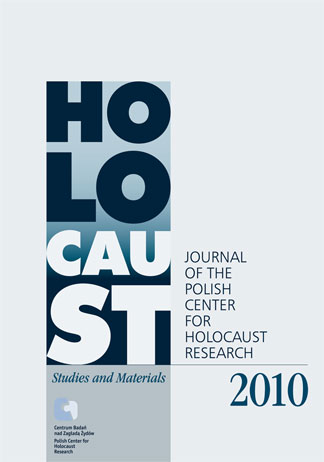Szaber Frenzy
Zagłada Żydów. Studia i Materiały, 2010, Pages: 173-203
Submission Date: 2020-10-04Publication Date: 2010-11-30
 https://doi.org/10.32927/ZZSiM.124
https://doi.org/10.32927/ZZSiM.124
Abstract
The subject of this article is war, and especially post-war, szaber – a phenomenon of mass looting of unattended property. The text is divided into three parts. In the first part, I attempt to explain theoretically the origin of szaber, indicating (among other things) its links with the culture of poverty and a necessary condition for the szaber to take place – a moment of chaos and a temporary decline of the power structures. In the second part, I formulate a hypothesis that ethnic difference was a necessary condition for szaber to emerge. I illustrate it with examples from September 1939, when first we faced a phenomenon of mass looting of unattended property. The article also deals with the pillage of the ghettos by Poles in 1942. The third part is devoted to the highest wave of looting, which took place mostly in the Regained Western and Northern Territories, immediately after the war. The text is constructed in such a way that at the end I return to the origin of the phenomenon, formulating a thesis that it created a certain szaber culture
Keywords
looting (szaber) , war chaos , culture of poverty , property pillage
License
Copyright (c) 2010 Author&"Holocaust Studies and Materials"

This work is licensed under a Creative Commons Attribution 4.0 International License.
https://creativecommons.org/licenses/by/4.0
The journal is published under the Diamond Open Access Standard, CC-BY-4.0 Deed - Attribution 4.0 International - Creative Commons
Most read articles by the same author(s)
- Marcin Zaremba, “That Entire Jewish Band Is Finally Dead.” Extermination of Jews as presented in 1942 letters of German soldiers , Zagłada Żydów. Studia i Materiały: No. 10 (2014)
- Marcin Zaremba, “That load of Jews is finally dead.” Extermination of Jews as presented in 1942 letters of German soldiers , Zagłada Żydów. Studia i Materiały: No. Holocaust Studies and Materials (2017)
- Marcin Zaremba, Looting Frenzy , Zagłada Żydów. Studia i Materiały: No. 5 (2009)
- Marcin Zaremba, CV of the Pogrom , Zagłada Żydów. Studia i Materiały: No. 14 (2018)
Similar Articles
- Marcin Zaremba, Looting Frenzy , Zagłada Żydów. Studia i Materiały: No. 5 (2009)
- Nawojka Cieślińska-Lobkowicz, Traces of Unknown Pre-war Jewish Collectors and Owners of Works of Art , Zagłada Żydów. Studia i Materiały: No. 17 (2021)
- Nawojka Cieślińska-Lobkowicz, Predator. The Looting Activity of Pieter Nicolaas Menten (1899–1987) , Zagłada Żydów. Studia i Materiały: No. Holocaust Studies and Materials (2017)
- Nawojka Cieślińska-Lobkowicz, Professional Looter. On the looting activity of Pieter Nicolaas Menten (1899–1987) , Zagłada Żydów. Studia i Materiały: No. 11 (2015)
- Nawojka Cieślińska-Lobkowicz, Losy mienia kulturalnego polskich Żydów w okresie okupacji hitlerowskiej i w pierwszych latach powojennych , Zagłada Żydów. Studia i Materiały: No. 6 (2010)
- Nawojka Cieślińska-Lobkowicz, Polish. Jewish. ‘Post-Jewish’. Nazi Looting of Works of Art and Restitution Issues in Poland 1945‒2020 , Zagłada Żydów. Studia i Materiały: No. 16 (2020)
- Jan Borowicz, What Was Visible Immediately After the War? Forgotten 1940s Images of the Holocaust , Zagłada Żydów. Studia i Materiały: No. 17 (2021)
- Adam Kopciowski, Anti-Jewish Incidents in the Lublin Region in the Early Years after World War II , Zagłada Żydów. Studia i Materiały: 2008: Holocaust Studies and Materials
- Nawojka Cieślińska-Lobkowicz, Habent Sua Fata Libelli. Occupation-period art market in Warsaw and Jewish property , Zagłada Żydów. Studia i Materiały: No. 10 (2014)
- Anna M. Rosner, Kindertransports – British Campaigns to Rescue Jewish Children during 1938–1939 , Zagłada Żydów. Studia i Materiały: No. 12 (2016)
1 2 3 4 5 6 7 8 9 10 11 12 13 14 15 16 17 18 19 20 21 22 23 24 25 26 27 28 29 30 31 32 33 34 35 36 37 38 39 > >>
You may also start an advanced similarity search for this article.
 English
English
 Język Polski
Język Polski



 https://orcid.org/0000-0001-5036-1793
https://orcid.org/0000-0001-5036-1793

